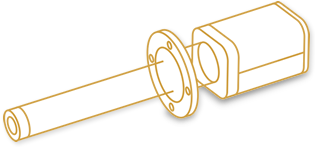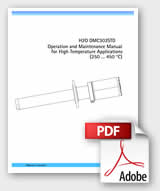Dry Scrubber Temp and Relative Humidity Control
Dry Scrubber SO2 removal efficiency is improved at lower scrubber outlet temperatures and higher relative
humidity. Learn how to monitor and optimize humidity, dew point temperature and
SO2 removal.
Scrubbers are currently designed to run at a thirty degree approach to dew point with a fixed moisture content used for the dew point calculation. Having an accurate and robust humidity sensor for control allows plants to always optimize the scrubber approach temperature and still prevent corrosion.
The dew point temperature of the flue gas for a coal fired boiler is dependent on the vapor pressure or volume fraction of water in the flue gas. So any ambient conditions or boiler auxiliary operations that
change the flue gas composition will also alter the saturation temperature of the flue gas. Unit
load, coal moisture variations, steam soot blowing, tube leaks and ambient air humidity changes
will affect the flue gas humidity content. Typical dry bulb temperature measurements cannot
detect changes in these humidity variables which result in less efficient and inherently higher risk
scrubber operation. Unit load, coal moisture variations and soot blowing cycles can possibly
change the moisture concentrations of the flue gas by 2 to 3% independently. Ambient air
humidity can change 1% by volume in a typical summer day (Table 1).
Table 1: Typical Ambient Data – Summer
| Time of Day | Dry Bulb Temperature (F) | Dew Point Temperature (F) | % Volume |
| 12:00 PM | 91 | 70 | 2.3 |
| 2:00 AM | 72 | 55 | 1.3 |
Table 2: Dew Point Temperature Change Based on 1% Volume Variance
| % Volume | Dry Bulb Temperature (F) | Dew Point Temperature (F) |
| 13% | 199 | 135.3 |
| 14% | 199 | 138.2 |
If the flue gas humidity content were to increase by 1% (Table 2) through any means, the operator would need to increase the scrubber outlet temperature by 3ºF to maintain the same safety margin.
Load condition plays an even larger role in flue gas humidity changes and with today’s plants running at lower loads at times, it is crucial to monitor the humidity. A change of 12 degrees in dew point can be seen from load changes in one day. A good rule of thumb is that every five degrees lower in approach to dew point temperature results in 5% in lime savings.
A humidity measurement is also very useful in identifying scrubber upsets such as nozzle erosion and plugging.
Feed Forward Scrubber Control
One approach is to install a humidity sensor prior to the dry scrubber, where the instrument can monitor the upstream moisture variables within the process and provide the added benefits of improved heat rate calculations, soot blower feedback and tube leak detection. An outlet dew point temperature can be calculated from the scrubber inlet humidity and the temperature drop across the scrubber. Scrubber upset conditions will not be identified with this type of control though. An alternative method is to install the instrument downstream of the scrubber and use the instrument’s output to directly control the water injection. This method has the advantage of being able to monitor scrubber upset conditions and detecting nozzle failures but will not be able to directly monitor tube leaks or other process variations like at the scrubber inlet. However, through careful monitoring of the system, operators should be able to detect tube leaks from a decrease in water injection rate needed to maintain humidity levels.
With the improved control on moisture injection and the ability to monitor the flue gas humidity
and flue gas dew point temperature in real-time, the plant should be able to increase SO2 removal
efficiency and improve limestone stoichiometry.
Figure 1. Inside of Duct – Dry Scrubber Outlet
Figure 2: 2 Sensors Across Dry Scrubber Outlet Duct
Figure 3: 1500 mm Probe Inserted Vertically Downward
Here is a link to a case study for this type of control, EUEC 2018 -Dry Scrubber – NID Optimization-2.
Have A Question?

H20 Moisture Sensor Applications
Air heater in-leakageDry scrubber control
Environmental reporting
And much more...




